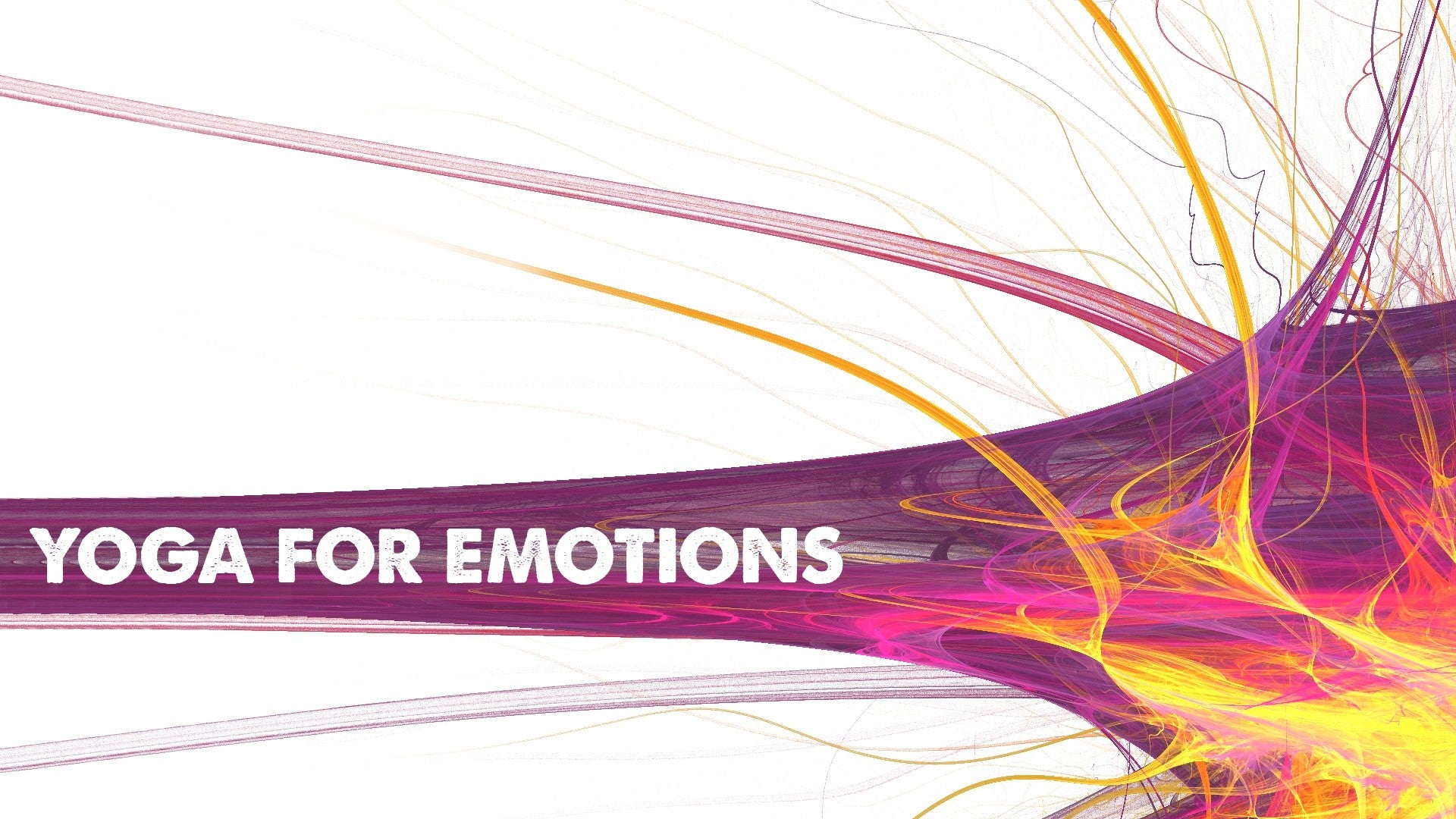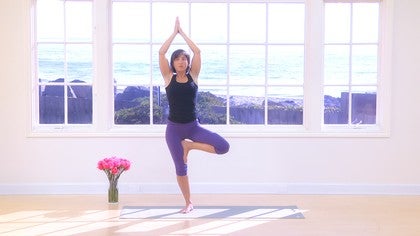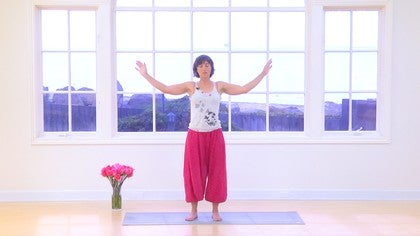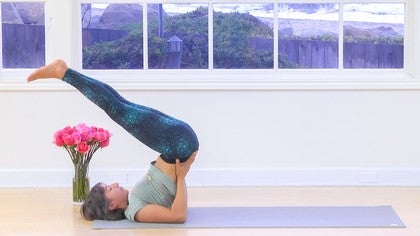Description
About This Video
Transcript
Read Full Transcript
So we've been playing with bringing the emotions or the moods into the mat, into the yoga practice. The reason for that is because they are already there and actually the body is the best way to get in connection with our emotions because this is how we feel them. Even though it's a plane between the mind and the body, our only way to really get to know them and support them is through the body. So that's the reason of the sequence that I would like to bring here today, which is for these days that we feel airy, like our feet are not on the ground, that we're really lacking this support that our emotions need. For these days that our fear is so strong that we can't really hold it. And so there is a way to work with our practice that will help us to ground us, to root it, to root us.
And maybe you are a person who naturally you are not really at all. So then this is the kind of practice you want to do all the time, but maybe for you it's just something of the moment. You are going in your life through a moment that you really need this grounding. The idea is finding this ability that we have to ground ourselves. So to start with this, in our body, obviously the vase is what we use for rooting down. So there is a downward energy called apana that helps us letting go of whatever we don't need anymore, but also helps us to keep the energy in the body so everything is not really going out. So to keep some energy and hold whatever we need to hold, like emotions and fear and changes we are facing.
So we are going to start working with the lower part of our body. So we are going to lay in supine. So you can bend your legs, relax your body down to the floor. Give yourself a moment so you can feel the breathing into the body. Maybe you want to bring your hands on the lower belly closer to your pelvis and feel the breathing there. And that simple thing is already helping you with grounding.
Just because you're bringing your awareness down there, you're feeling the breathing, that's already helping you. The other amazing thing of this posture is that here we are so aware of the sacrum. This amazing bone we have at the bottom of the spine and now the body, the weight of our pelvis is sitting on top of it. So the sacrum is really available to you right now. So bring your mind there and be aware of the contact between your sacrum and the earth.
Now you can allow your knees to fall to the sides while your feet, soul of the feet together. Maybe you want to still keep your hands here for a little bit longer because that feels good when you're knitting, when you're in need of grounding. And now try to bring the awareness into what we call mola dar or mola banda, which would be the perineum. So it's like the muscles on the solar pelvis, so on the floor of the pelvis. So try to bring the awareness down there and see if there is some movement that comes with the breathing.
We have been observing the movement of the breathing in the body, so now the suggestion is can you feel some movement there in your pelvic floor while you breathe in and out. And don't worry if you can't feel it, it's okay, it's just a suggestion. So you bring your mind there and keep the mind there observing if something shows up. And when I say no worries, because we're going to start now working actively on it, so I'm sure that you will start feeling something in there. So what we're going to do is open the arms in an angle, so your chest is also quite open. And from here we're going to start rolling the pelvis on top of the sacrum, rolling the pelvis over the sacrum.
But we're going to start the movement pushing one sole of the feet against the other sole of the feet. That will bring the momentum for the pelvis to move. So you push both feet one against the other and then you roll the pelvis, flattening the lower back on the floor, and then you relax this tension, this pushing of your feet and allow the pelvis to naturally come back to its normal position. So pushing with your feet, you're rolling the pelvis, and then when you relax the feet, allow the pelvis to naturally come back to its natural position. And you combine these with the breathing. So what's interesting here is that when you are actually pushing, what you're doing is exhaling, and when you're relaxing, you're allowing the in-breath.
And now can you observe what is happening down there in your pelvic floor? Can you feel your pelvic floor breathing, moving with you? Okay, pause, stretch the legs, stretch the arms, shavasana, and just feel. Feel this rush in your legs, the sensations in the body, in the pelvis, pelvic floor. So already your mind is kind of more focused on this side of the body, which is helping you to root down. Usually it's that simple, you just bring your awareness there, and something is already happening at an energetic level, really.
Okay, and let's start playing with our legs and hips and pelvis a little bit more. So it's easy, we're just gonna bend the leg and slide the leg up, and then bring it into the chest, and down again. So we're really working with the hip joint, but the idea is to observe the ambience here at the pelvis, because when we're standing, we're using our legs to ground ourselves. And maybe you can bring a little bit more movement, so you can start playing a little bit. Maybe there is a little bit of momentum that can help you do a little bit of torsion. So you know, playfulness, playing, it's allowed when you're doing yoga. So when you're practicing in your place, just see where it takes you. And pause and feel.
And now there is all this intense sensation in this leg, in this side of the body. And then you can start playing with the other leg. You can start slow, mind fully moving your leg, feeling the atmosphere, the ambient here. And then you can start playing a little bit more. There's no one there, so you can just play. There are no rules.
So you're free to play for as long as you want here. And then just go back to Shavasana, relax and feel. There's so much happening inside now, wow. And we're going to use all this focus that we have and these intense sensations that we have now in our pelvis. And we're going to do a bridge. So you're coming to regular asanas in a traditional way. So bring your hand sides of the body, push with your feet, rooting down on the earth, and bring your pelvis up, pubic bone up, all the way up. Allowing your heart to open, remember you're so rooted now that already you can allow your heart to open in a safe way and stay here as long as you want.
Feeling this strong rooting, grounding through your pelvis, your legs and your feet. You can make any variations in this posture that feels good or right to you. And then when you're ready, slowly, slowly, mindfully, feel each vertebra going down, allow your pelvis to roll and just relax one more time in Shavasana. And then you just turn to the side to sit, sitting up, and sit in a comfortable position, whatever works for you and if you need to put a pillow. So it feels more comfortable.
And here feel the rooting. So you can feel the sitting bones, these bones we have here, where the thigh finds the buttocks. These bones are kind of pointy. So you can play a little bit here, so you can feel really like there is a pointy thing and then you find the right balance in there. Usually your sacrum is not touching the floor, but it can happen that because there is not opening enough in your pelvis, your sacrum is kind of touching the floor. And then I will suggest that you put a pillow and you sit on a pillow, allowing your hips to move a little bit forward.
And then just root here and feel this energy moving down and feel how you can really hold it. And I find that if you want to ground yourself, it's really helpful to work with the breathing in your spine. And for me it helps that if I want to ground myself, I do the exhalation going down. So I inhale from the earth to the sky and I exhale, rooting. If I have too much earth and what I want to do is the opposite, I breathe the opposite way, but now we are talking about grounding, so it feels good. Inhaling up and exhaling down. And we're going to move to all fours, finding the right alignment, wrists underneath your shoulders, knees just below your hips.
And we're going to do Marjoryasana, but we're going to put the emphasis on our pelvis and sacrum. So basically we're going to be aware that we are starting the movement in the pelvis, opening when we inhale and then rounding when we exhale. This is an amazing posture because you can do it for any purpose. You just change the focus. That's another thing with yoga. It depends on where you put the focus. It will have an effect or a completely different one. So here we are observing the sitting bones, the sacrum, the whole pelvis, leading the movement and giving this grounding that we need in our lives. And you can stay here for a little bit longer, bringing the sitting bones into play.
And then you can move to Chalasana, so you keep the hips leveled with your knees and you bring the arms forward, opening the chest. And now you can allow your heart to open because you are already rooted and you keep on rooting down through your hips and legs, basically aligning your sitting bones with your knees. And that helps with the opening of the heart in a safe way. And then you bring your hands at the level of your face, tucking the toes and up to Adho Moka. Adjust the posture. You are allowed to bend your knees. You don't need to stretch your legs. You are allowed to bend your knees and then you can stretch, lengthen the spine, which is what we really want here. And we can start moving the energy in this posture to help us ground. So feel your hands deeply rooted into the earth.
And feel when you inhale that you inhale through your hands, through the palms of your hands, up towards your sacrum, exhaling from the sacrum down to the soul of the feet. And then root from the soul of the feet down to the earth. Inhale there and bring the breathing up to the sacrum and down towards your hands. Inhaling in your hands, up to the sacrum, exhaling down your legs towards your feet, inhaling soul of the feet, up to your sacrum, exhaling down towards your hands. So you keep on moving your breathing, gathering energy from the earth and back to the earth again. Inhaling soul of the feet to the sacrum, exhaling sacrum hands, inhaling hand sacrum, exhaling sacrum soul of the feet.
Now you can walk slowly, slowly with your hands, with your feet towards your hands and stop and pause and relax in Uttanasana. So without losing this connection, we can't attempt Virksasana. This is like the classical balance posture in yoga. That helps actually a lot with rooting, so you don't have to do crazy stuff to root down and ground yourself. So be aware of the soul of your feet and decide what leg will be the first leg to support you and bring all the body weight there in that leg that it will support you. And slowly, slowly start bringing the other leg up and you can choose different postures for the other leg.
It doesn't really matter whatever feels better for you. The most important thing is that you keep the awareness on this leg that is supporting you. Because if I start thinking about something else, then I'm going to lose this, which is what I need to stay in the posture just in one leg. So basically, the balance comes because I'm focused. And then from here, you can bring your hands into your heart, allowing the heart to breathe because you're rooting down.
And you can even bring your arms up so the heart has more space and you're moving towards the light, the knowledge, the understanding of whatever needs to be revealed. And you can support whatever comes today because you're really grounded. And then slowly, slowly bring the hands down back to your heart and slowly, slowly under the posture go back to both feet. Close your eyes. Be with the sensations in the body. Really, it's not important what your mind is telling you now, so go back to the sensations in the body.
Because usually, balancing postures are really challenging for the mind. So the mind has this tendency to start judging after them. So just be with whatever you're feeling in your body. You can sense the difference between one leg and the other. So let's attempt the other side. So bring the body weight into the other leg.
Be sure that this leg will support you, sustain you. And when you're ready, then it's time to bring the other leg up wherever you choose to put it. And then when this is solid, you can bring your hands in front of your heart and you feel this. Just when you bring the hands in front of your heart, suddenly you can feel like an opening. And then you can bring the arms up, allowing more space for your heart to blossom.
And when you're ready, you bring the hands down, back to your heart, and slowly, slowly bring the leg down. Close your eyes and be with it. That's the yummy part. And if we want to expand a little bit this sensation of grounding, spreading the legs helps a lot. So we are building a nice triangle. So it's like usually we have only one pointed thing going down.
But now we are, wow, gaining a lot of surface that is grounding us. So again, feel the sole of the feet on the floor. Maybe you want to play a little bit with your toes. Allow the pelvis to be comfortable so there is no discomfort in the lower back. Just close your eyes for a sec and feel all that space in between your legs.
And then I think it's really nice. I'm going to turn so you can see it. I think it's really nice when you do this because we are talking about grounding. I think it's really nice that you go and touch your sitting bones. And then when you move forward, because this is what we're going to do now, you're actually kind of pulling up. That's really nice. That helps a lot.
Because really the sitting bones are really important for grounding purposes. So you grab them, you have them, they're yours, so go ahead. And then bring the heart forward, bring the sitting bones up, helping with your hands. And then there is a moment where you see, oh, this is getting too much. So here just relax, allow your back to curl, round, bend, head hanging, and arms hanging.
And here you can play a little bit, bringing the body weight more into your heels and bringing the sitting bones a little bit farther back. I find that that helps. There are several ways of doing this posture. It doesn't really matter today because our purpose is rooting down. So choose whatever feels right for you and stay in here, feeling this big space of the triangle in between your legs.
And because you're rooted, you can open your heart a little bit more. Bring your hands forward and open the heart. Go back to the center, turn. You want to turn both feet. Bring one hand on the outside of the foot and the other hand on the inside and bend on top of your front leg.
You might need to bend the front leg. That's okay. It's not really important. Then let's go back to prasarita. Bring the feet parallel. Relax and pause.
You might want to open the heart a little bit again so you can feel. How does it feel to open the heart when you are being grounded? And grounding yourself. And then as you're ready, just work with your hands, move the feet and fold on top of the front leg. And if you need to bend it, go ahead and do it.
And let's go back, prasarita. And slowly, slowly bring the feet heel-toes, heel-toes a little bit closer so you can stand slowly, slowly rolling your back. Back to ktadasana. Close your eyes and listen. Okay, and you can go down now. So simply roll down one more time so you can squat and then sit.
And then patasana. I really like this posture. Patasana. I think that Eriv Shivman calls it Krishna-macharya, asana. Anyway, it's a really nice posture. It's not really orthodox in yoga because you know the back is kind of rounding but it feels so good to be here. And it helps so much to feel this grounding and that you can really relax in here. Head hanging. So you don't have to hold the weight of your head anymore.
Okay, so from here we can go to Bhadakonasana. This is a really nice posture for grounding. So basically you want to bring the sole of the feet together. You don't want to bring the feet really close to your pubic bone because that will make it difficult so it's not allowing the pelvis to roll and we want the pelvis to be able to roll. So you bring it a little bit farther, grab the feet, lengthen the spine and when you're ready you just roll from your pelvis so you're feeling that you're rolling on top of the sitting bones.
The pubic bone is getting closer to the ground and then finally you just let go, surrender to the posture. And really enjoy this sensation of surrendering. When you want to go out of the posture, bring the heart open and move away from the posture. And we're going to move to Bhadrasana to pause here. And for some of you this is a difficult posture.
Some people you will find that there is a lot of pain in here but if you see it every day a little bit on this posture it's really nice because I find that this is one of the best ways to relax. And there is important connection. So the sitting bones are connected to the heels that go all the way down to the earth. And you can allow your pelvis to be completely relaxed. There is not a right way to put it.
The pelvis just finds its natural way. So you can really rest here. Or if this is too much on the dorsum of your foot or your feet you can tuck in the toes like the Japanese do in saison and just sit there. Or you could even use a pillow or a blanket in between the thighs and the legs to release some of the tension there. Again grounding, feeling this downward energy rooting you.
And we are going to use this posture if you can stay in it. If not you just sit cross-legged and that will work as well. But we are going to use this posture Bhadrasana to do a side opening. So basically what you do is you leave the buttocks and sit. So when you are sitting, the heel, I don't know if you can see this.
When you are sitting, when I am moving to the side and I am sitting, actually I am sitting on top of the heel. Yeah? Kind of. So it's really sweet if you find that spot where the heel is actually touching the perineum. So it's like in between your buttocks, right there, sitting in there, nesting in there.
And then you allow the hand to touch the floor. And you bring the arm up and you spread the side of the body, relax the shoulder and open to the side. And then inhaling up and exhaling, bring the arm down. And then you change sides, so now I am going to sit on top of this heel. And then relax the other arm down, relax the shoulder and bring this arm up so you are creating space at the side of the body.
Softly breathing here, and the sense of rooting, the sensation of rooting is so intense. And then bring it up, back in by shrasana, and just relax. There is actually more play that you can do here. If your knees allow it, you could sit in between your feet. Virasana.
So now, really, your pelvic floor is almost touching the floor. And just stay in there. And again, you do this only if that feels right for your knees. If it doesn't, just undo it. Sit in any other way, you will be rooting and grounding anyway.
But if you are here, maybe you want to play a little bit farther and you want to go down. And again, allow your heart to open and the head to hang. Roll up, one hand, the other. And here, maybe you just want to play a little bit with the torsion, so bring the hand rooting down on the ground, and the opposite hand outside of the opposite thigh, and just slight torsion looking over your shoulder. But keep some awareness here in this connection between the sitting bones and the heels, and then connect it to the air.
Slowly, slowly, undo. And build it on the other side, root down through this arm. Opposite thigh, open the heart, look over the shoulder. Don't lose this connection. So keep the awareness also in this connection, heels, sitting bones, earth.
And then slowly, slowly, back to the center, and you're ready to roll down in shavasana, and relax. Back home, back to the earth, relax your legs, feel your hips, your pelvis, everything soft. If you feel the need, you can bring your hands in your lower belly, or even keep one hand here, and the other one on your heart. And stay there for a little longer, feeling this connection between your body and the earth. Because the earth is there always supporting you.
So when you feel airy, when you feel that you're needing grounding, just actually, if you just lay down, most of the work is already done. Thanks for being here. Namaste.
Yoga for Emotions
Comments
You need to be a subscriber to post a comment.
Please Log In or Create an Account to start your free trial.


















